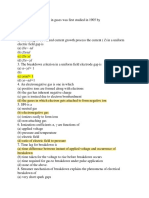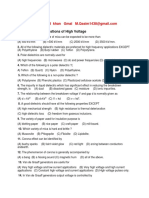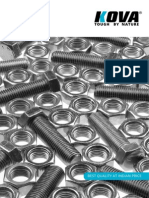0 ratings0% found this document useful (0 votes)
1 - Unit 3 MCQ
1 - Unit 3 MCQ
Uploaded by
RAMESH KUMAR MAURYAThe document contains 35 multiple choice questions about dielectric materials and their properties, high voltage measurement techniques, and insulation. Some key points covered are:
- Mica has one of the highest dielectric strengths, over 1500 kV/mm.
- Polar dielectrics like nylon are used for power frequencies while non-polar materials like polystyrene are used for high frequencies.
- Impurities in liquid dielectrics like moisture reduce breakdown strength.
- Surge diverters contain nonlinear resistors and spark gaps to limit overvoltages.
- Impulse voltages are characterized by polarity, peak value, and time to half peak value.
Copyright:
© All Rights Reserved
Available Formats
Download as PDF, TXT or read online from Scribd
Download as pdf or txt
1 - Unit 3 MCQ
1 - Unit 3 MCQ
Uploaded by
RAMESH KUMAR MAURYA0 ratings0% found this document useful (0 votes)
The document contains 35 multiple choice questions about dielectric materials and their properties, high voltage measurement techniques, and insulation. Some key points covered are:
- Mica has one of the highest dielectric strengths, over 1500 kV/mm.
- Polar dielectrics like nylon are used for power frequencies while non-polar materials like polystyrene are used for high frequencies.
- Impurities in liquid dielectrics like moisture reduce breakdown strength.
- Surge diverters contain nonlinear resistors and spark gaps to limit overvoltages.
- Impulse voltages are characterized by polarity, peak value, and time to half peak value.
Original Title
1- unit 3 mcq
Copyright
© © All Rights Reserved
Available Formats
PDF, TXT or read online from Scribd
Share this document
Did you find this document useful?
Is this content inappropriate?
The document contains 35 multiple choice questions about dielectric materials and their properties, high voltage measurement techniques, and insulation. Some key points covered are:
- Mica has one of the highest dielectric strengths, over 1500 kV/mm.
- Polar dielectrics like nylon are used for power frequencies while non-polar materials like polystyrene are used for high frequencies.
- Impurities in liquid dielectrics like moisture reduce breakdown strength.
- Surge diverters contain nonlinear resistors and spark gaps to limit overvoltages.
- Impulse voltages are characterized by polarity, peak value, and time to half peak value.
Copyright:
© All Rights Reserved
Available Formats
Download as PDF, TXT or read online from Scribd
Download as pdf or txt
0 ratings0% found this document useful (0 votes)
1 - Unit 3 MCQ
1 - Unit 3 MCQ
Uploaded by
RAMESH KUMAR MAURYAThe document contains 35 multiple choice questions about dielectric materials and their properties, high voltage measurement techniques, and insulation. Some key points covered are:
- Mica has one of the highest dielectric strengths, over 1500 kV/mm.
- Polar dielectrics like nylon are used for power frequencies while non-polar materials like polystyrene are used for high frequencies.
- Impurities in liquid dielectrics like moisture reduce breakdown strength.
- Surge diverters contain nonlinear resistors and spark gaps to limit overvoltages.
- Impulse voltages are characterized by polarity, peak value, and time to half peak value.
Copyright:
© All Rights Reserved
Available Formats
Download as PDF, TXT or read online from Scribd
Download as pdf or txt
You are on page 1/ 11
Unit III MCQ
1. Dielectric strength in case of mica can be expected to be more
than
(A) 500 kV/mm
(B) 1500 kV/mm
(C) 2500 kV/mm
(D) 3500 kV/mm.
A
2. All of the following dielectric materials are preferred for high
frequency applications EXCEPT
(A) Polyethylene
(B) Butyl rubber
(C) Teflon
(D) Polystyrene.
B
3. Polar dielectrics are normally used for
(A) high frequencies
(B) microwaves
(C) dc and power frequencies
(D) none of the above.
C
4. Which of the following is a polar dielectric ?
(A) Teflon
(B) Quartz
(C) Nylon
(D) Polyethylene.
C
5. Which of the following is a non-polar dielectric ?
(A) Polystyrene
(B) Phenolic plastics
(C) Plasticized cellulose acetate
(D) Castor oil.
A
6. The impurity in liquid dielectric which has significant effect in
reducing the breakdown strength, is
(A) dust
(B) dissolved gases
(C) moisture
(D) ionic impurities.
C
7. The relationship between the breakdown voltage V and gap d
is normally given as
(A) d = kV2
(B) d=kV3
(C) V = kd
(D) v = kdn.
D
8. A good dielectric should have all the following properties
EXCEPT
(A) high mechanical strength
(B) high resistance to thermal deterioration
(C) high dielectric loss
(D) freedom from gaseous inclusions.
C
9. The variety of paper used for insulation purpose is
(A) blotting paper
(B) rice paper
(C) craft paper
(D) mill-board.
C
10. Which variety of mica is hard and brittle ?
(A) Muscovite
(B) Phlogopite
(C) Fibiolite
(D) Lipidolite.
D
11. Corona effect can be identified by
(A) bushy sparks
(B) faint violet glow
(C) red light
(D) arcing between conductors and earth.
B
12. The phenomenon of corona is generally accompanied by
(A) a bang
(B) a hissing sound
(C) magnetic hum
(D) all of the above.
B
13. Van de Graaff generators are useful for
(A) Very high voltage and low current applications
(B) Very high voltage and high current applications
(C) Constant high voltage and current applications
(D) High voltage pulses only.
A
14. In Van de Graaff generators output voltage is controlled by
(A) controlling the corona source voltage
(B) controlling the belt speed
(C) controlling the lower spray point
(D) any of the above.
A
15. A Tesla coil is a
(A) cascaded transformer
(B) coreless transformer
(C) high frequency resonant transformer
(D) low impedance transformer.
C
16. Switching surge is
(A) high voltage dc
(B) high voltage ac
(C) short duration transient voltage
(D) hyperbolically dying voltage.
C
17. Moles bridge is used to measure
(A) properties of dielectric at dc
(B) dispersion in insulation
(C) high frequency high voltages
(D) modulation ratio frequencies.
B
18. Insulators for high voltage applications are tested for
(A) power frequency tests
(B) impulse tests
(C) both (A) and (B) above
(D) none of the above.
C
19. Impulse testing of transformers is done to determine the
ability of
(A) bushings to withstand vibrations
(B) insulation to withstand transient voltages
(C) windings to withstand voltage fluctuations
(D) all of the above.
B
20. Transformers contribute to radio interference due to
(A) corona discharges in air
(B) internal or partial discharges in insulation
(C) sparking
(D) any of the above.
D
21. As compared to air the relative dielectric strength of sulphur
hexafluoride is nearly
(A) 1.5 times
(B) 2.5 times
(C) 4.0 times
(D) 5.0 times.
B
22. The electrical breakdown strength of insulating materials
depends on
(A) nature of applied voltage
(B) imperfections in dielectric material
(C) pressure, temperature and humidity
(D) all of the above.
D
23. Which of the following gas has been used as insulating
medium in electrical appliances ?
(A) Nitrogen
(B) Carbon dioxide
(C) Sulphur hexafluoride
(D) Freon.
C
24. Vacuum insulation is used in all of the following EXCEPT
(A) Particle accelerators
(B) EHT of color TV
(C) Field emission tubes
(D) X-rays.
B
25. Liquids are generally used as insulating materials up to
voltage stresses of about
(A) 100 MV/cm
(B) 50 MV/cm
(C) 50 kV/cm
(D) 500 V/cm.
C
26. Electro-mechanical breakdown of solid insulating materials
occurs due to
(A) magnetic bum
(B) vibrations
(C) mechanical stresses produced by the electrical field
(D) electrical stresses produced by the voltage fluctuations.
C
27. Surge voltage originate in power systems due to
(A) lightning
(B) switching operations
(C) faults
(D) any of the above.
D
28. All of the following are the preferred properties of a
dielectric gas EXCEPT
(A) high dielectric strength
(B) physiological inertness
(C) low atomic number
(D) good heat transfer.
C
29. Corona results in
(A) improvement in power factor
(B) increased capacitive reactance of transmission lines
(C) radio interference
(D) better regulation.
C
30. Which of the following technique/method is-used for the
measurements of ac high frequency voltages ?
(A) Peak voltmeter
(B) Series resistance micro ammeter
(C) Resistance potential divider
(D) Any of the above.
A
31. Which of the following method or technique can be used for
the measurement of high dc voltages ?
(A) Generating voltmeter
(B) Electrostatic voltmeter
(C) Peak voltmeter
(D) Any of the above.
A
32. All of the following methods/techniques can be used for the
measurement of high ac voltages EXCEPT
(A) Potential dividers
(B) Potential transformers
(C) Electrostatic voltmeters
(D) Half effect generators.
D
33. Surge diverters are
(A) non-linear resistors in series with spark gaps which act as fast
switches
(B) arc quenching devices
(C) shunt reactors to limit the voltage rise due to Ferranti effect
(D) over-voltages of power frequency harmonics.
A
34. Impulse voltages are characterized by
(A) polarity
(B) peak value
(C) time of half the peak value
(D) all of the above.
D
35. Paschen's law is associated with
(A) breakdown voltage
(B) ionization
(C) thermal radiations
(D) none of the above.
A
You might also like
- MCQ Electrical TRANSMISSION DISTRIBUTION and Cables100% (1)MCQ Electrical TRANSMISSION DISTRIBUTION and Cables28 pages
- Most Important Electrical Engineering NTS Based Short Questions100% (1)Most Important Electrical Engineering NTS Based Short Questions72 pages
- Objective Type Question or MCQ of Transmission and Distribution83% (18)Objective Type Question or MCQ of Transmission and Distribution62 pages
- FPSC Assistant Executive Engineer (Electrical) Test: Electronics100% (3)FPSC Assistant Executive Engineer (Electrical) Test: Electronics7 pages
- Multiple Choice Questions of High VoltageNo ratings yetMultiple Choice Questions of High Voltage4 pages
- Multiple Choice Questions of High Voltage Engineering (01-15)No ratings yetMultiple Choice Questions of High Voltage Engineering (01-15)25 pages
- SodaPDF-converted-BEE3 HVE MCQ 91 Suggestions WITHOUT ANSWERS 18th Junel 2022No ratings yetSodaPDF-converted-BEE3 HVE MCQ 91 Suggestions WITHOUT ANSWERS 18th Junel 202215 pages
- Government College of Engineering - Bargur Department of Electrical &electronics EngineeringNo ratings yetGovernment College of Engineering - Bargur Department of Electrical &electronics Engineering28 pages
- Most Important Electrical Engineering NTS Based Short QuestionsNo ratings yetMost Important Electrical Engineering NTS Based Short Questions63 pages
- Power Systems and EHVAC Objective Questions70% (30)Power Systems and EHVAC Objective Questions50 pages
- Objective Questions Multiple Choice Questions of High Voltage Engineering (01-15)No ratings yetObjective Questions Multiple Choice Questions of High Voltage Engineering (01-15)4 pages
- Ehv Ac & DC Transmission MCQ Unit - 2: Ans: (D)100% (2)Ehv Ac & DC Transmission MCQ Unit - 2: Ans: (D)23 pages
- 16ee302/ Transmission and Distribution S.Jayashree Ap/EeeNo ratings yet16ee302/ Transmission and Distribution S.Jayashree Ap/Eee7 pages
- Ee 8701 - High Voltage Engineering: Unit 1 - Causes of Over Voltages100% (1)Ee 8701 - High Voltage Engineering: Unit 1 - Causes of Over Voltages22 pages
- MGM College of Engineering and Technology, Kamothe: Third Year Electrical Student ActivityNo ratings yetMGM College of Engineering and Technology, Kamothe: Third Year Electrical Student Activity2 pages
- Interviews and Test Based Short Multiple Choice Questions For Electrical Engineers Other Students 06-06-160% (1)Interviews and Test Based Short Multiple Choice Questions For Electrical Engineers Other Students 06-06-1628 pages
- Transmission and Distribution-Mcq by Manas Khanda75% (4)Transmission and Distribution-Mcq by Manas Khanda29 pages
- BSNL JTO Placement Papers: SemiconductorNo ratings yetBSNL JTO Placement Papers: Semiconductor6 pages
- Practice Set of Multiple Choice Questions: Subject: EHVAC Date: 26/06/2022No ratings yetPractice Set of Multiple Choice Questions: Subject: EHVAC Date: 26/06/20226 pages
- BSNL GE-JTO Recruitment Examination: Magnetic FieldNo ratings yetBSNL GE-JTO Recruitment Examination: Magnetic Field10 pages
- 110 Top Most Switchgear PROTECTIONS - Electrical Engineering Objective Type Questions and AnswersNo ratings yet110 Top Most Switchgear PROTECTIONS - Electrical Engineering Objective Type Questions and Answers19 pages
- 135 TOP Transformers - Electrical Engineering Multiple Choice Questions and AnswersNo ratings yet135 TOP Transformers - Electrical Engineering Multiple Choice Questions and Answers25 pages
- Mcqs Preparation For Engineering Competitive ExamsNo ratings yetMcqs Preparation For Engineering Competitive Exams22 pages
- Electrical Engineering Important Mcq-Transmission and Distribution100% (1)Electrical Engineering Important Mcq-Transmission and Distribution16 pages
- Faculty Faculty of Degree Engineering - 083: High Voltage Engineering (2160904) Multiple Choice QuestionsNo ratings yetFaculty Faculty of Degree Engineering - 083: High Voltage Engineering (2160904) Multiple Choice Questions33 pages
- 110 TOP MOST SWITCHGEAR PROTECTIONS - Electrical Engineering Objective Type Questions and Answers100% (1)110 TOP MOST SWITCHGEAR PROTECTIONS - Electrical Engineering Objective Type Questions and Answers11 pages
- Electromagnetic Compatibility (EMC) Design and Test Case AnalysisFrom EverandElectromagnetic Compatibility (EMC) Design and Test Case AnalysisNo ratings yet
- Vacuum Nanoelectronic Devices: Novel Electron Sources and ApplicationsFrom EverandVacuum Nanoelectronic Devices: Novel Electron Sources and ApplicationsNo ratings yet
- Reviews in Computational ChemistryFrom EverandReviews in Computational ChemistryAbby L. ParrillNo ratings yet
- Alboniga v. Broward County School BoardNo ratings yetAlboniga v. Broward County School Board41 pages
- REFRIGERATION & AIR CONDITIONING April 2017 PDFNo ratings yetREFRIGERATION & AIR CONDITIONING April 2017 PDF8 pages
- Mohammad Faghfoory: Mohammad Hassan Faghfoory Is An Iranian-American IslamicNo ratings yetMohammad Faghfoory: Mohammad Hassan Faghfoory Is An Iranian-American Islamic3 pages
- 1st Test in Mapeh Arts and Music Grade 7 For ScreenNo ratings yet1st Test in Mapeh Arts and Music Grade 7 For Screen4 pages
- Systems Programming For The Intel ArchitectureNo ratings yetSystems Programming For The Intel Architecture14 pages
- Trouble Deploying OVF Template From Vsphere Datastore (2117310) - VMware KBNo ratings yetTrouble Deploying OVF Template From Vsphere Datastore (2117310) - VMware KB2 pages
- A Novel Design To External Filament Extruder For 3D PrinterNo ratings yetA Novel Design To External Filament Extruder For 3D Printer9 pages
- Practice Teaching Demonstration: Intramuscular Injection100% (2)Practice Teaching Demonstration: Intramuscular Injection13 pages
- Revolutionizing Non-Conventional Wound Healing Using Honey by Simultaneously Targeting Multiple Molecular Mechanisms PDFNo ratings yetRevolutionizing Non-Conventional Wound Healing Using Honey by Simultaneously Targeting Multiple Molecular Mechanisms PDF10 pages
- ARC - Building A Comprehensive Industrial Wireless FutureNo ratings yetARC - Building A Comprehensive Industrial Wireless Future10 pages
- MCQ Electrical TRANSMISSION DISTRIBUTION and CablesMCQ Electrical TRANSMISSION DISTRIBUTION and Cables
- Most Important Electrical Engineering NTS Based Short QuestionsMost Important Electrical Engineering NTS Based Short Questions
- Objective Type Question or MCQ of Transmission and DistributionObjective Type Question or MCQ of Transmission and Distribution
- FPSC Assistant Executive Engineer (Electrical) Test: ElectronicsFPSC Assistant Executive Engineer (Electrical) Test: Electronics
- Multiple Choice Questions of High Voltage Engineering (01-15)Multiple Choice Questions of High Voltage Engineering (01-15)
- SodaPDF-converted-BEE3 HVE MCQ 91 Suggestions WITHOUT ANSWERS 18th Junel 2022SodaPDF-converted-BEE3 HVE MCQ 91 Suggestions WITHOUT ANSWERS 18th Junel 2022
- Government College of Engineering - Bargur Department of Electrical &electronics EngineeringGovernment College of Engineering - Bargur Department of Electrical &electronics Engineering
- Most Important Electrical Engineering NTS Based Short QuestionsMost Important Electrical Engineering NTS Based Short Questions
- Objective Questions Multiple Choice Questions of High Voltage Engineering (01-15)Objective Questions Multiple Choice Questions of High Voltage Engineering (01-15)
- 16ee302/ Transmission and Distribution S.Jayashree Ap/Eee16ee302/ Transmission and Distribution S.Jayashree Ap/Eee
- Ee 8701 - High Voltage Engineering: Unit 1 - Causes of Over VoltagesEe 8701 - High Voltage Engineering: Unit 1 - Causes of Over Voltages
- MGM College of Engineering and Technology, Kamothe: Third Year Electrical Student ActivityMGM College of Engineering and Technology, Kamothe: Third Year Electrical Student Activity
- Interviews and Test Based Short Multiple Choice Questions For Electrical Engineers Other Students 06-06-16Interviews and Test Based Short Multiple Choice Questions For Electrical Engineers Other Students 06-06-16
- Practice Set of Multiple Choice Questions: Subject: EHVAC Date: 26/06/2022Practice Set of Multiple Choice Questions: Subject: EHVAC Date: 26/06/2022
- BSNL GE-JTO Recruitment Examination: Magnetic FieldBSNL GE-JTO Recruitment Examination: Magnetic Field
- 110 Top Most Switchgear PROTECTIONS - Electrical Engineering Objective Type Questions and Answers110 Top Most Switchgear PROTECTIONS - Electrical Engineering Objective Type Questions and Answers
- 135 TOP Transformers - Electrical Engineering Multiple Choice Questions and Answers135 TOP Transformers - Electrical Engineering Multiple Choice Questions and Answers
- Mcqs Preparation For Engineering Competitive ExamsMcqs Preparation For Engineering Competitive Exams
- Electrical Engineering Important Mcq-Transmission and DistributionElectrical Engineering Important Mcq-Transmission and Distribution
- Faculty Faculty of Degree Engineering - 083: High Voltage Engineering (2160904) Multiple Choice QuestionsFaculty Faculty of Degree Engineering - 083: High Voltage Engineering (2160904) Multiple Choice Questions
- 110 TOP MOST SWITCHGEAR PROTECTIONS - Electrical Engineering Objective Type Questions and Answers110 TOP MOST SWITCHGEAR PROTECTIONS - Electrical Engineering Objective Type Questions and Answers
- Electromagnetic Compatibility (EMC) Design and Test Case AnalysisFrom EverandElectromagnetic Compatibility (EMC) Design and Test Case Analysis
- O level Physics Questions And Answer Practice Papers 3From EverandO level Physics Questions And Answer Practice Papers 3
- Vacuum Nanoelectronic Devices: Novel Electron Sources and ApplicationsFrom EverandVacuum Nanoelectronic Devices: Novel Electron Sources and Applications
- O level Physics Questions And Answer Practice Papers 1From EverandO level Physics Questions And Answer Practice Papers 1
- Mohammad Faghfoory: Mohammad Hassan Faghfoory Is An Iranian-American IslamicMohammad Faghfoory: Mohammad Hassan Faghfoory Is An Iranian-American Islamic
- 1st Test in Mapeh Arts and Music Grade 7 For Screen1st Test in Mapeh Arts and Music Grade 7 For Screen
- Trouble Deploying OVF Template From Vsphere Datastore (2117310) - VMware KBTrouble Deploying OVF Template From Vsphere Datastore (2117310) - VMware KB
- A Novel Design To External Filament Extruder For 3D PrinterA Novel Design To External Filament Extruder For 3D Printer
- Practice Teaching Demonstration: Intramuscular InjectionPractice Teaching Demonstration: Intramuscular Injection
- Revolutionizing Non-Conventional Wound Healing Using Honey by Simultaneously Targeting Multiple Molecular Mechanisms PDFRevolutionizing Non-Conventional Wound Healing Using Honey by Simultaneously Targeting Multiple Molecular Mechanisms PDF
- ARC - Building A Comprehensive Industrial Wireless FutureARC - Building A Comprehensive Industrial Wireless Future

























































































